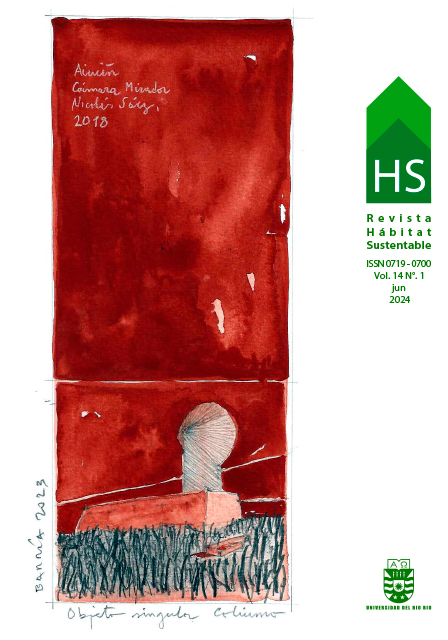Enhancing energy efficiency in glass facades through biomimetic design strategies
DOI:
https://doi.org/10.22320/07190700.2024.14.01.03Keywords:
biomimicry, facade design, energy efficiency, thermoregulationAbstract
The building industry, responsible for a large proportion of energy consumption, is looking for solutions to reduce energy consumption. This study proposes biomimetic facades to ensure thermal comfort. Firstly, it examined biomimetic façade systems in the literature. Then, it analyzed the thermoregulation methods of nature, the level of biomimicry, and the strategies used by living things. As a result of the analyses, biological information regarding the three selected phenomena was expanded upon, determining how to transfer the biomimicry method to a building envelope. Energy simulations were conducted on the glass façade of the Süleyman Pasha Bath to evaluate the envelope’s energy efficiency. It was found that nature-inspired methods significantly contributed to the building's energy consumption when examining the simulation results of the façade designed.
Downloads
References
ALY, Z., IBRAHIM, A., & ABDELMOHSEN, S. (2021). Augmenting passive actuation of hygromorphic skins in desert climates: learning from thorny devil lizard skins. In 9th International Conference of the Arab Society for Computer Aided Architectural Design, American University in Cairo, Egypt.
Asknature (n.d.). https://asknature.org/strategy/leaves-protect-from-freezing/
BADARNAH, L., FARCHI, Y. N., & KNAACK, U. (2010). Solutions from nature for building envelope thermoregulation. Design & Nature V: Comparing Design in Nature with Science and Engineering, 5, 251. https://doi.org/10.2495/DN100221
Cactus Kingdom (n.d.). https://cactuskingdom.ca/product/fenestraria-aurantiaca-baby-toes-seed/
ÇAĞLAR, S. (2020). Voronoi Diyagramları Dünyayı Anlamamızı Nasıl Sağlar? https://www.matematiksel.org/voronoi-diyagramlari-dunyayi-anlamamizi-nasil-saglar/
ENGIN, N. (2012). Enerji Etkin Tasarımda Pasif İklimlendirme: Doğal Havalandırma. Tesisat Mühendisliği, 129, 62-70. https://www.mmo.org.tr/sites/default/files/c8aa7c541085a2b_ek.pdf
FARAGALLA, A. M., & ASADI, S. (2022). Biomimetic design for adaptive building façades: a paradigm shift towards environmentally conscious architecture. Energies, 15(15), 5390. https://doi.org/10.3390/en15155390
FARCHI NACHMAN, Y. (2009). Learning from nature: Thermoregulation envelope, in Department of Building Technology. Delft University of Technology: Façade Design.
HELMS, M., VATTAM, S. S., & GOEL, A. K. (2009). Biologically inspired design: process and products. Design Studies, 30(5), 606–622. https://doi.org/10.1016/j.destud.2009.04.003
International Energy Agency. Energy Efficiency (2019). Buildings, The global exchange for energy efficiency policies, data and analysis.
KAHRAMANOĞLU, B., & ALP, N. Ç. (2021). Kinetik Sistemli Bina Cephelerinin Modelleme Yöntemlerinin İncelenmesi. AURUM Journal of Engineering Systems and Architecture, 5(1), 119-138. https://doi.org/10.53600/ajesa.861479
KALATHA, A. (2016). The water wall: A bio-inspired thermoregulative facade system. [Unpublished master thesis], Delft University of Technology, Netherlands.
KIM, K., & TORRES, A. (2021). Integrated Façades for Building Energy Conservation; IC-AIRES, Lecture Notes in Networks and Systems; Springer: Cham, Switzerland; 361.
KURU, A., OLDFIELD, P., BONSER, S., & FIORITO, F. (2019). Biomimetic adaptive building skins: Energy and environmental regulation in buildings. Energy and Buildings, 205, 109544. https://doi.org/10.1016/j.enbuild.2019.109544
LEE, E. S., & TAVIL, A. (2007). Energy and visual comfort performance of electrochromic windows with overhangs. Building and Environment, 42(6), 2439-2449. https://doi.org/10.1016/j.buildenv.2006.04.016
MUTLU AVINÇ, G., & ARSLAN SELÇUK, S. (2019). Mimari Tasarımda Biyomimetik Yaklaşımlar: Pavyonlar Üzerine Bir Araştırma. Online Journal Of Art & Design, 7(2), 92-107. http://www.adjournal.net/articles/72/728.pdf
ÖZTÜRK, BÜŞRA., (2023). Çağdaş eklerin tarihi yapının enerji performansına etkisinin incelenmesi [MSc thesis]. Konya Teknik University, Institute of Graduate Education, Konya.
PACHECO, R., ORDÓÑEZ, J., & MARTÍNEZ, G. (2012). Energy efficient design of building: A review. Renewable and Sustainable Energy Reviews, 16(6), 3559-3573. https://doi.org/10.1016/j.rser.2012.03.045
SHEIKH, W. T., & ASGHAR, Q. (2019). Adaptive biomimetic facades: Enhancing energy efficiency of highly glazed buildings. Frontiers of Architectural Research, 8(3), 319-331. https://doi.org/10.1016/j.foar.2019.06.001
SOMMESE, F., BADARNAH, L., & AUSIELLO, G. (2022). A critical review of biomimetic building envelopes: Towards a bio-adaptive model from nature to architecture. Renewable and Sustainable Energy Reviews, 169, 112850. https://doi.org/10.1016/j.rser.2022.112850
TABADKANI, A., ROETZEL, A., LI, H. X. & TSANGRASSOULIS, A. (2021). Design approaches and typologies of adaptive façades: A review. Automation in Construction. 121, 103450. https://doi.org/10.1016/j.autcon.2020.103450
PAAR, M. J., & PETUTSCHNIGG, A. (2016). Biomimetic inspired, natural ventilated facade–A conceptual study. Journal of Facade Design and Engineering, 4(3-4), 131-142. https://doi.org/10.3233/FDE-171645
ZARI, M. P. (2007). Biomimetic approaches to architectural design for increased sustainability. In The SB07 New Zealand Sustainable Building Conference, 33-42. https://www.semanticscholar.org/paper/BIOMIMETIC-APPROACHES-TO-ARCHITECTURAL-DESIGN-FOR-Zari/1a7b024096491c64beafc4d9b243f84a321cd697
Downloads
Published
How to Cite
Issue
Section
License
Copyright (c) 2024 Büşra Öztürk, Güneş Mutlu-Avinç, Semra Arslan-Selçuk

This work is licensed under a Creative Commons Attribution-ShareAlike 4.0 International License.
The content of articles which are published in each edition of Habitat Sustentable, is the exclusive responsibility of the author(s) and does not necessarily represent the thinking or compromise the opinion of University of the Bio-Bio.
The author(s) conserve their copyright and guarantee to the journal, the right of first publication of their work. This will simultaneously be subject to the Creative Commons Recognition License CC BY-SA, which allows others to share-copy, transform or create new materials from this work for non-commercial purposes, as long as they recognize authorship and the first publication in this journal, and its new creations are under a license with the same terms.











 Scientific Information Program/Concurso Fondos de Publicación de Revistas Científicas 2018/ Proyecto Mejoramiento de Visibilidad de Revistas UBB (Código:FP180007).
Scientific Information Program/Concurso Fondos de Publicación de Revistas Científicas 2018/ Proyecto Mejoramiento de Visibilidad de Revistas UBB (Código:FP180007).





